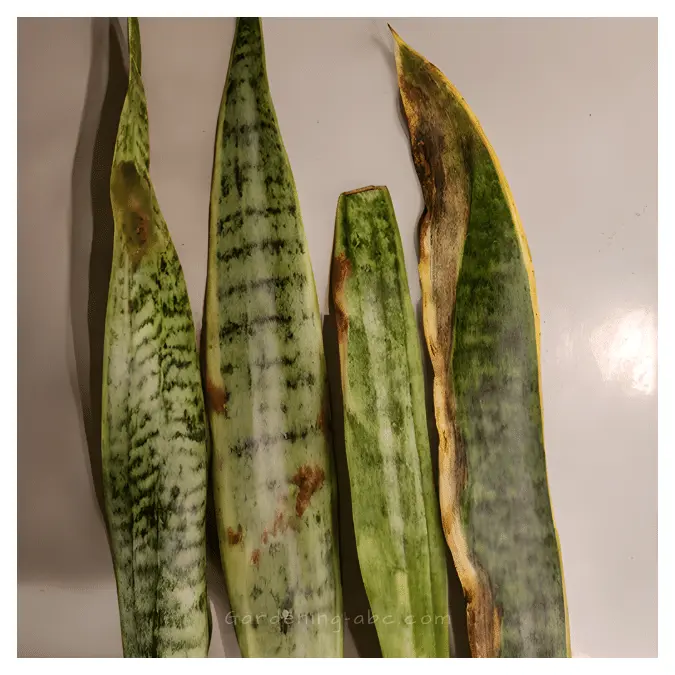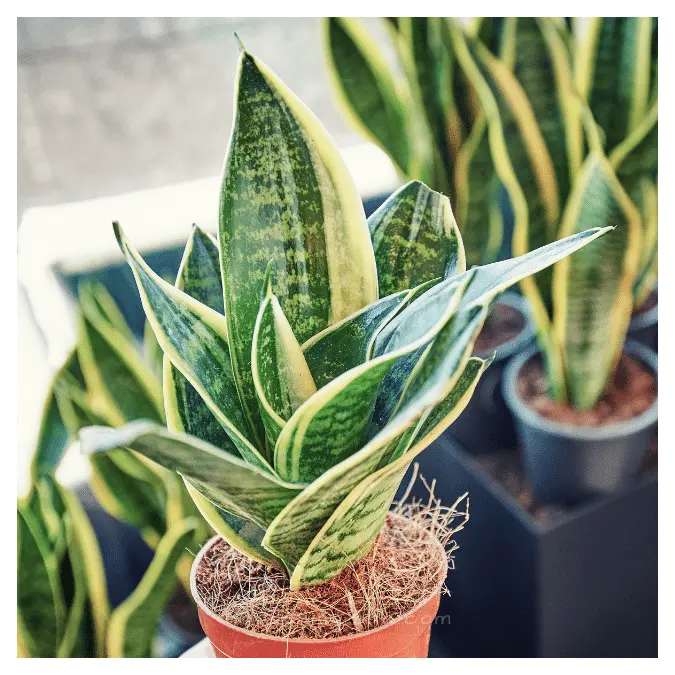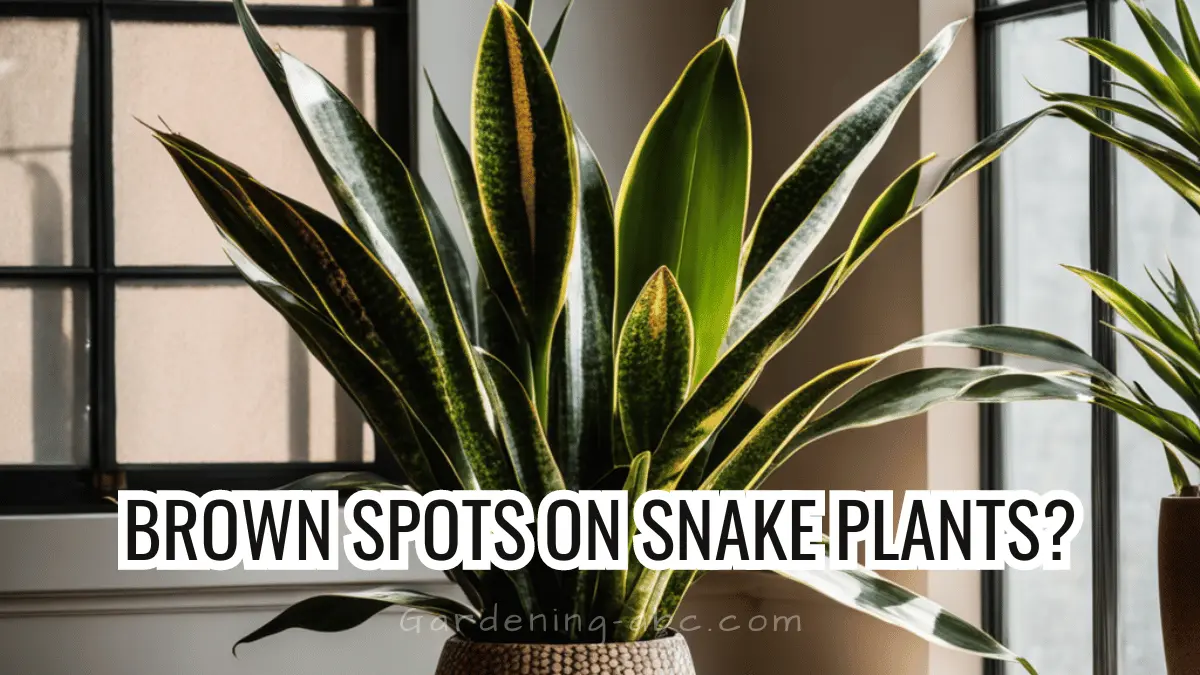We use affiliate links to run our site. When you buy through links on our site, we may earn an affiliate commission, without any added cost to you. Learn more
As a passionate gardener, I know how distressing it can be to notice those ugly brown spots marring the otherwise gorgeous foliage of your beloved snake plants.
While snake plants are fairly hardy, they are not completely immune to certain problems that can cause brown spots on their leaves. Understanding the various causes can help you diagnose the issue and take steps to prevent and treat brown spots on your snake plants.
In this post, I’ll share the 6 most common reasons for brown spots on snake plants along with tips on how to prevent and treat them, so you can get your plants looking lush and healthy again.
Overwatering
Excessive watering is one of the prime causes of brown spots on snake plants. These succulents store water in their thick leaves and stems and therefore require infrequent watering.
Overwatering causes root rot due to lack of oxygen in the soggy soil. Root rot prevents the roots from absorbing nutrients and water properly, leading to brown spots on the leaves.
Here are some tips to prevent overwatering:
- Check the soil moisture before watering. Only water when the top 1-2 inches of soil are dry.
- Ensure the pot has drainage holes at the bottom and use a well-draining potting mix.
- Water thoroughly until it drains from the bottom holes, then discard excess water in the saucer.
- Cut back on watering frequency in winter when plants are dormant.
If you suspect overwatering, allow the soil to dry out completely before watering again. Trim off any severely damaged leaves and stems.
How to Find Your Watering Sweet Spot for Snake Plants
Underwatering
While snake plants are drought tolerant, insufficient watering can also cause brown spots due to dehydration. The leaves start yellowing and shriveling up before developing brown lesions.
To prevent underwatering:
- Check soil moisture by poking your finger into the soil before watering.
- Water thoroughly until excess drains out from the bottom when the top few inches of soil are dry.
- Maintain a consistent watering schedule based on your environment.
- Increase watering frequency in summer or in dry, hot conditions.
You can revive an underwatered snake plant by giving it a good, deep drink and getting onto a better watering regime. Damaged parts may not recover fully but new healthy growth will emerge.
Chlorinated Water

The chlorine and fluoride in tap water can accumulate in the soil over time and cause brown spotting on snake plant leaves.
Using filtered, bottled, or rainwater is ideal. If using tap water, make sure to let it sit for 24-48 hours before using so the chemicals can dissipate.
You can also install an activated carbon filter on your tap to remove chlorine and fluoride.
Excessive Sunlight
While snake plants can tolerate low light conditions, too much direct sun can scorch and burn their leaves, causing brown spots and crispy edges.
Place your snake plant in a spot that receives bright indirect light or filtered sunlight. Slowly acclimate it if moving it from low to higher light conditions.
Rotate the pot periodically so all sides get even sunlight exposure. Use sheer curtains to filter harsh afternoon sun shining directly on the plant.
Temperature Fluctuations
Sudden drops in temperature below 55°F can induce cold stress and shock in snake plants. This causes brown spots on the leaves as the plant struggles to adjust.
Keep your snake plant at a steady temperature around 65-80°F during the day and above 55°F at night. Place it away from drafty windows, vents, and doors. Move it indoors before the first frost if grown outdoors.
Overfertilization
Snake plants are not heavy feeders and can get by with minimal fertilization. Using a highly concentrated fertilizer too often can build up salts in the soil leading to fertilizer burn.
I recommend using a balanced houseplant fertilizer at half strength once every 6-8 weeks during spring and summer only. Completely avoid fertilizer in fall and winter when plants are dormant.
If you suspect fertilizer burn, leach the soil by heavily watering it to wash away excess salts. Hold off on fertilizing for a few months till the plant recovers.
The Rare and Fascinating World of Snake Plant Flowers
Pests or Diseases
Certain pests like spider mites, mealybugs, and fungus gnats can infest snake plants and cause brown spotting on the leaves as they feed on plant fluids.
Bacterial and fungal diseases like southern blight, leaf spot, and rust can also lead to the appearance of brown lesions.
To prevent pests and diseases:
- Keep leaves clean by wiping them with a damp cloth.
- Isolate infected plants and prune affected parts.
- Use neem oil spray or insecticidal soap to control pests.
- Apply copper fungicide or sulfur powder to manage fungal diseases.
- Ensure good air circulation around plants.
Catching infestations early and taking prompt action is key to managing pests and diseases on snake plants.
How to Treat Existing Brown Spots on Snake Plants

If your snake plant already has brown spots, here are some treatment tips to restore its health:
- Identify and fix the underlying cause, whether it’s overwatering, pests, etc. Prevention is the best cure!
- Prune off badly damaged and dead leaves and stems. Use clean, sharp scissors or shears.
- Wipe remaining leaves with neem oil, hydrogen peroxide, or copper fungicide solution.
- Repot in fresh potting mix if the roots are rotten. Trim affected roots.
- Move the plant to a suitable spot based on its light and temperature needs.
- Maintain proper watering and fertilization practices.
- Be patient! Damaged parts will not recover but new healthy growth will emerge.
With a little detective work and attentive care, those pesky brown spots on your snake plant will soon be a thing of the past. A healthy plant starts from the roots, so focus on getting the basics right.
Final Thoughts on Preventing Brown Spots on Snake Plants
Snake plants are relatively hassle-free houseplants but can develop issues like brown spots if their basic needs are not met.
By understanding what causes the problem and addressing it early on, you can take proactive steps to maintain your snake plants in top form.
I hope these tips help you pinpoint what is ailing your snake plant and how to fix it. Let me know in the comments if you have any other tricks for keeping brown spots at bay!
Frequently Asked Questions
Why does my snake plant have liquid brown spots?
Liquid brown spots that ooze or drip are usually caused by bacterial or fungal diseases like southern blight or bacterial leaf spot. Overwatering can also cause brown soggy spots as roots rot. Check for root rot and treat with a fungicide.
What causes dry brown spots on snake plant leaves?
Dry brown spots are often due to underwatering or low humidity. Check soil moisture regularly and water thoroughly when the top inches are dry. Mist leaves occasionally or use a pebble tray to boost humidity. Harsh sun can also burn spots.
How can I save my snake plant with fungus?
Act quickly to stop it spreading. Isolate plant, prune off the worst leaves and treat with sulfur powder or copper fungicide spray. Remove any mushy roots and repot in sterile soil. Space out plants, avoid wet leaves and water only when partly dry.
Amazon and the Amazon logo are trademarks of Amazon.com, Inc, or its affiliates.

Hi there! My name is Prasenjit and I’m an avid gardener and someone who has grown a passion for growing plants. From my hands-on experience, I have learned what works and what doesn’t. Here I share everything I have learned.
